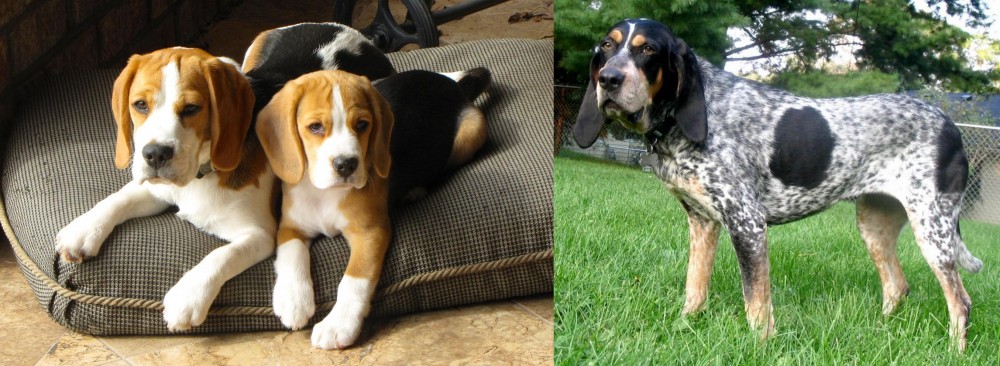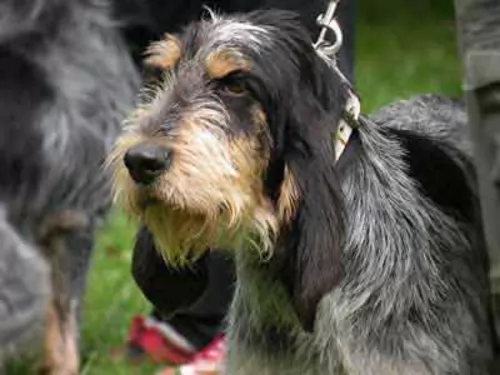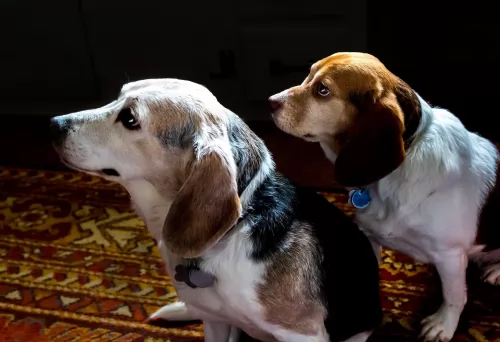 Petzlover
Petzlover Beagle is originated from United Kingdom but Griffon Bleu de Gascogne is originated from France. Beagle may grow 16 cm / 6 inches shorter than Griffon Bleu de Gascogne. Beagle may weigh 16 kg / 35 pounds lesser than Griffon Bleu de Gascogne. Beagle may live 4 years more than Griffon Bleu de Gascogne. Beagle may have more litter size than Griffon Bleu de Gascogne. Beagle requires Low Maintenance. But Griffon Bleu de Gascogne requires Moderate Maintenance
Beagle is originated from United Kingdom but Griffon Bleu de Gascogne is originated from France. Beagle may grow 16 cm / 6 inches shorter than Griffon Bleu de Gascogne. Beagle may weigh 16 kg / 35 pounds lesser than Griffon Bleu de Gascogne. Beagle may live 4 years more than Griffon Bleu de Gascogne. Beagle may have more litter size than Griffon Bleu de Gascogne. Beagle requires Low Maintenance. But Griffon Bleu de Gascogne requires Moderate Maintenance
 There are some accounts of similar size dogs used for hunting in Greece in 5th century BCE. During 8th century the Talbot Hound breed was created. In 11th century Talbot Hound was brought to England by William the Conqueror. While using in hunting they are found to be a slow runner. To overcome the situation and increase their running speed the hunting people bred Talbot Hound with Grey hounds. The beagles described earlier were very small in size and are said as pocket beagles.
There are some accounts of similar size dogs used for hunting in Greece in 5th century BCE. During 8th century the Talbot Hound breed was created. In 11th century Talbot Hound was brought to England by William the Conqueror. While using in hunting they are found to be a slow runner. To overcome the situation and increase their running speed the hunting people bred Talbot Hound with Grey hounds. The beagles described earlier were very small in size and are said as pocket beagles.
 The Griffon Bleu de Gascogne dog hails from France and is descended from crosses between the Bleu de Gascogne as well as the Griffon Nivernais. Dog experts tell us that the Grand Griffon Vendeen is also part of the mix.
The Griffon Bleu de Gascogne dog hails from France and is descended from crosses between the Bleu de Gascogne as well as the Griffon Nivernais. Dog experts tell us that the Grand Griffon Vendeen is also part of the mix.
Raised as working dogs, with his good nose and alertness, he has always been used as a single hunting dog or being used as part of a pack.
It was in 1920 that the first Griffon Bleu de Gascogne breed standard was written in France, and over the decades, the dog hasn’t changed much in looks except that it is slightly taller.
This is a rare breed not much seen outside of France, but breeding attempts have taken it from ‘close to extinction’ to a popular pet today.The Griffon Bleu de Gascogne was recognized by the United Kennel Club in 1991.
 They are small and compact breed, and always happy and fun loving. They should be trained by patient and creative training techniques. Beagles are very much interested in using their nose in finding interesting scents and are food focussed. They always wake their neighbours at 6 am by their half howling. They think everyone is their best friend and love to have friendship with other animals and humans. They have about 220 million scent receptors and are said as "a nose with feet" by humorist Dave Barry.
They are small and compact breed, and always happy and fun loving. They should be trained by patient and creative training techniques. Beagles are very much interested in using their nose in finding interesting scents and are food focussed. They always wake their neighbours at 6 am by their half howling. They think everyone is their best friend and love to have friendship with other animals and humans. They have about 220 million scent receptors and are said as "a nose with feet" by humorist Dave Barry.
We can see beagles at many airports in their duty. They can easily trace out the illegal things being smuggled. Since they are small in size they are suitable for apartment living. But they like to walk around several times. They should be exercised for plenty of time. Obedience training should be given to them by giving food reward. Beagles are wanderers of nature and so if possible they will try to escape. So it is necessary to make them microchipped or to wear a collar, to find them easily.
 This is a medium to large sized scenthound. He stands at anything between 48 to 57cms and weighs between 16 and 27kg.
This is a medium to large sized scenthound. He stands at anything between 48 to 57cms and weighs between 16 and 27kg.
He has a long, wiry type of coat which is usually a mottled white and black, taking on a blue hue look. There are tan marking above the eyes and around the muzzle. The ears of the dog are long and floppy, he has that typical soulful look in his brown eyes and the tail is long with a curve at the point.
The Griffon Bleu de Gascogne is an intelligent dog breed, capable of learning quickly and therefore will do well with training and socialization.
This popular docile dog gets on well with other pets in the home as well as with children. He is alert and energetic but is known to be a loyal and loving dog, being good with children, particularly those he grew up with.
The dog isn't particularly well suited to city life simply because of his high energy. He will require a good deal of exercise, so essentially he needs a home with a fair sized garden. He will want to join you on your walks. Walks provide your pet with stimulation and are good for socializing a dog too.
 They are very good companion for children. They love to play and spend time with children.
They are very good companion for children. They love to play and spend time with children.
They have millions of scent receptors and so they can be seen in Airports and many important places in duty. Also they are interested in hunting small rodents.
They adapt well for apartment living but they don't like being alone for a long time. If kept alone for a long time in back yard they will begin to bark and dig pit or try to escape. Beagle likes hot weather more than cold weather.
Beagles are difficult to train up. Many people say it will take about one year to house train beagles. They have an attitude of "what's in it for me". But it depends on the personality and temperament of the individual.
 Your Griffon Bleu de Gascogne is such a popular pet in France and Spain simply because he is so amicable, getting on well with everyone in the home.
Your Griffon Bleu de Gascogne is such a popular pet in France and Spain simply because he is so amicable, getting on well with everyone in the home.
He is everything that a pet lover wants – loving, protective, friendly and companionable. They get on well with other pets too and they’re easy to train, becoming super obedient. Add to that the fact that he isn’t a sickly dog and is also fairly low maintenance.
This dog has all it takes to make him the most splendid pet.
 Beagle's ears should be checked occasionally for any sign of infections like discoloured wax, dirt or foul odour. Also their nails should be trimmed regularly. They should be exercised regularly in order to maintain a proper weight. The most common health problems in beagles are obesity, epilepsy and allergies.
Beagle's ears should be checked occasionally for any sign of infections like discoloured wax, dirt or foul odour. Also their nails should be trimmed regularly. They should be exercised regularly in order to maintain a proper weight. The most common health problems in beagles are obesity, epilepsy and allergies.
They are average shedders and having short hair thus it is easy to groom. They should be made to bath with a mild and non irritant shampoo.
 As a healthy dog breed, your Griffon Bleu de Gascogne isn't likely to cost you much at the vet. Nonetheless there are some common dog ailments that you need to be aware of.
As a healthy dog breed, your Griffon Bleu de Gascogne isn't likely to cost you much at the vet. Nonetheless there are some common dog ailments that you need to be aware of.
Some dog owners, when buying a Griffon puppy, want to see health clearance certificates to show that the parents of the puppy are free from the like of certain diseases such as hip dysplasia and von Willebrand's disease.
This is a condition where your dogs thighbone doesn't fit properly into the hip joint. Your puppy can develop this condition from 4 months of age already.
With some dogs you can see the pain, and they may even become lame in one or both back legs. Hip dysplasia is hereditary, but environmental factors such as an injury or the wrong diet can contribute towards your pet succumbing to hip dysplasia.
A skin allergy can make your pet totally miserable as they lick and scratch with discomfort, pain and irritation. All the scratching and licking can cause secondary infections and your pet can even lose his hair.
Atopic Dermatitis is when your dog is allergic to things like dust or pollen. Some people look at homeopathic treatments for dogs and are pleased with the results. The thing is you need to get help for your pet as it can cause your pet endless misery.
 After 4 weeks of birth the puppy can be given solid foods by slowly increasing the ratio for many weeks. The recommended food is fresh meat of chicken breast, lamb, turkey and lean hamburger. The vegetables can be given as raw or steamed. The vegetables that will be good for them are raw baby carrots, broccoli, cauliflower and sweet peas. The puppies should be fed 3 to 4 small meals per day as they require more nutrients for their growth.
After 4 weeks of birth the puppy can be given solid foods by slowly increasing the ratio for many weeks. The recommended food is fresh meat of chicken breast, lamb, turkey and lean hamburger. The vegetables can be given as raw or steamed. The vegetables that will be good for them are raw baby carrots, broccoli, cauliflower and sweet peas. The puppies should be fed 3 to 4 small meals per day as they require more nutrients for their growth.
The grown up dog should be fed with the same food and 1 complete meal is enough for them. The meal should be given at noon. The food should be given based on calories as they should not get overweight. In addition to food, fruits such as blueberries, raspberries, banana and mango can also be given to them periodically.
Beagles should be exercised daily in order to maintain proper weight. Beagles are average shedders and having short hair which is easy to groom. They should be made to bath periodically with a mild shampoo.
Moderate exercise such as walking and cardio exercise such as chasing a ball should be given to them for staying them to be active and for maintaining good health.
 The Griffon Bleu de Gascogne is a rough, shaggy, fairly long coated dog and is an average shedder. He will therefore require regular brushing to get rid of grass and burrs that cling to the hair, causing it to matt and tangle.It's always a good chance for you to check him over for ticks and fleas too.
The Griffon Bleu de Gascogne is a rough, shaggy, fairly long coated dog and is an average shedder. He will therefore require regular brushing to get rid of grass and burrs that cling to the hair, causing it to matt and tangle.It's always a good chance for you to check him over for ticks and fleas too.
He has floppy ears, so these will require cleaning to prevent infections. Check his nails too and trim them as needed. Take him to the vet for this if you're not sure how or you don't have the correct grooming tools.
Just like his human family, a dog needs to have his own sleeping spot – a place which is warm and dry and which he can retreat too. It is a good idea to train your dog to sleep in his own place where there are some warm blankets which are clean and comfortable for him.
You chose to bring a dog into your home, and it is therefore your responsibility to see that he is looked after well.
To keep him healthy, he will require high-quality kibble twice a day. How much your Griffon eats will depend on his age and his activity levels. Follow the feeding directions carefully on the packaging to ensure you keep him in good shape.
Remove the boredom of the same food every day by adding in some raw meat as well as cooked chicken, rice and vegetables as a tasty treat. This will keep him alert, healthy and his coat shiny. Fresh, cool water should be constantly available.